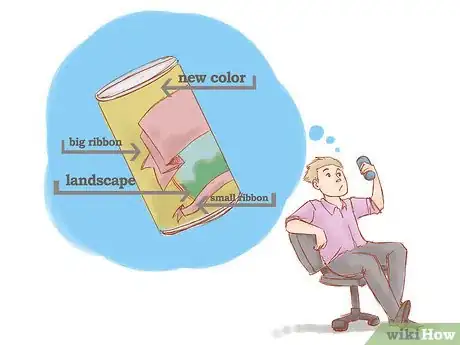This article was co-authored by Paul Chernyak, LPC. Paul Chernyak is a Licensed Professional Counselor in Chicago. He graduated from the American School of Professional Psychology in 2011.
This article has been viewed 227,216 times.
Daydreaming is one of the best ways to engage your imagination for both inspiration and creative solutions. When you give your mind time to wander, you'll be amazed at how creative you can be. Daydreaming about achieving your goals can also help motivate you to pursue them. Next time you have a few free minutes to spend, consider daydreaming instead of playing a video game or reading news articles online. You'll feel more relaxed, positive and motivated as a result.
Steps
Getting Started
-
1Give yourself permission. Daydreaming sometimes gets a bad rep, since some people see it as a waste of time. When you have 20 minutes of downtime, shouldn't you be using it more productively? Studies show that daydreaming actually is productive. It has the power to help you be more creative and even motivate you to achieve your goals. So go ahead and give yourself permission to make daydreaming part of your day.
- A study conducted at the University of California, Santa Barbara found that daydreamers did 41 percent better on tests measuring creative thinking than people who didn't daydream.[1]
- On the other hand, when you let your mind wander away from the present to fantasies that will probably never come true, like wishing you would win the lottery, daydreaming can actually make you feel less happy. Studies seem to indicate that focusing on the present moment leads to greater happiness, so try not to let your daydreaming turn into escapism.[2]
-
2Free yourself of other distractions. Daydreaming, like dreaming at night, is best done when you're in a relatively peaceful environment without a lot of pulls on your attention. Before you start a daydreaming session, try to create a quiet, relaxing atmosphere for yourself, even if you only have a few minutes to spare. This can be done anywhere, anytime, whether you're at home or out and about during your day.
- If you can, find a quiet spot in which to daydream, like an empty room or even the bathroom. If you want to daydream in a public place, wearing headphones is a good way to quiet your world enough to let your mind wander. But make sure you pay a little attention to the outside world every now and again.
- Before you daydream, make sure you aren't hungry, thirsty or otherwise in need of something that could distract you from your daydream.
- Listening to music can help tune out other distractions and also make the daydream even better, as music is full of emotion. Just pick songs that fit the mood of the dream you are having.
Advertisement -
3Gaze out a window or close your eyes. Everyone's "daydreaming face" is a little different. Some people find it easy to let their minds wander while gazing out a window or staring into space, while others prefer to close their eyes. Do whatever helps you feel most relaxed and able to think without getting too distracted.
-
4Let your mind wander in a positive direction. There are several types of daydreams, and they don't all have a positive effect on your mind and mood. If you let your mind get consumed by negative thoughts (like, say, taking revenge on your ex) you end up dragging you down. But the great thing about daydreaming is that you can control your thoughts (it's a lot easier than the nighttime corollary, lucid dreaming to make sure that each daydreaming session leaves you feeling uplifted.[3]
- Positive-constructive daydreaming is linked with openness to new experiences, happiness and creativity.[4]
- On the other hand, guilty-dysphoric daydreaming, like fantasizing about failure, bad things happening or hurting others, leads to negative emotions like anxiety and guilt.
- The third type of daydreaming happens when you have poor attention control; your mind wanders all over the place because you have difficulty paying attention to the present. This type of daydreaming doesn't have a positive effect since it's not under your control. If you find you that you struggle paying attention to the present moment so much that it impacts your daily life, consider speaking with a mental health professional.[5]
Knowing What to Dream About
-
1Dream about the future you want. Daydreaming with a goal in mind can help you motivate yourself to achieve it. Let yourself imagine your life as you'd like it to turn out. Play out your future as you see it unfolding, giving yourself total freedom to indulge your fantasies. Will you become president? Move to a tropical island? Start your own company? Fall in love and start a family? In your daydreams, anything is possible.
- Try imagining all the things that would make you happy and putting them into a story. Keeping the story and characters consistent will make it more fun and easier when finding yourself in different surroundings. Keep your stories and situations positive, and build on them each time you daydream.
- You could also try creating a vision board. These are fantastic tools for situations where you're trying to imagine a specific outcome or need motivation to achieve a goal.
-
2Dream about your favorite things. Maybe it's not quite as productive as dreaming about your goals, but it's fun to daydream about your favorite things. Dream about things that make you happy, like certain people, activities, places, even foods that bring a smile to your face. Keep in mind, however, that if you make a habit of dreaming of your favorite things as a way to take your mind off of what's right in front of you, you might experience a decrease in happiness.[6]
- For example, give yourself a lift by daydreaming about your favorite vacation spot. Your daydream will increase your happiness more if you actually have plans to go there at some point.
- But if you let yourself daydream about something that's unattainable, like getting romantically involved with someone who isn't single, daydreaming can be a recipe for frustration.
-
3Roleplay in your dreams. Imagine a real life situation and act it out in your mind. Act out the movements in your mind just as powerfully as if you were going to do it. This will enhance your problem-solving ability and your ability to think from another person's point of view.
- For a different twist, imagine yourself thrown into the world of your favorite book or movie. What would you do? How would the other characters react to your sudden appearance? (Unless you were there all along?) What would the antagonist say?
- You could also imagine yourself as someone else, and think about what qualities you admire in them. How would the person react to different situations and problems?
-
4Dream up something creative. Daydreaming is an excellent way to come up with brand new ideas for stories, music, art and innovative products. Let your mind run wild and see what you can dream up. Don't let anything be off-limits!
- For example, you could think of a product you like and figure out what would make it better and how you could achieve that.
- If you like your ideas, don't forget to write them down. You just may end up using them.
Knowing Where to Daydream
-
1Daydream during breaks in class or at work. The great thing about daydreaming is that you can really do it anytime, anywhere. Give your mind a break when you have free time between classes or work projects. When you find yourself with time to spare, try daydreaming instead of turning to your cell phone or computer for entertainment. Your tired brain will thank you![7]
- Daydreaming during class or work may be a popular past time, but it can get you into trouble if you aren't paying attention to what's happening in front of you. Try to concentrate on what's happening in the moment and save your daydreaming for when your environment is truly free from distractions.
-
2Daydream in a car, train or bus. Daydreaming while you're along for the ride is one of the best ways to do it. There's something about seeing the world rush by outside a car, train or bus window that helps the mind relax and just let go. Try to get a window seat and take the opportunity to let your mind wander where it will.
-
3Daydream while you exercise. If you like to run, swim, walk, or do other solitary exercise activities, you already have built-in daydreaming opportunities. Use the time to think about whatever you'd like, whether it's coming up with a plot for a short story you're writing or planning out your Christmas vacation.
-
4Daydream in the morning and at night. Early in the morning and at night before you drift off to sleep are great times to daydream. You're already in bed, and your mind is relaxed with few other distractions. Logic seems to interfere less when you are too tired to care that your daydream is absolutely ridiculous.
Expert Q&A
Did you know you can get expert answers for this article?
Unlock expert answers by supporting wikiHow
-
QuestionHow can I daydream a whole new idea that I've never thought of before? I like action and fantasy books like The Hunger Games.
 Paul Chernyak, LPCPaul Chernyak is a Licensed Professional Counselor in Chicago. He graduated from the American School of Professional Psychology in 2011.
Paul Chernyak, LPCPaul Chernyak is a Licensed Professional Counselor in Chicago. He graduated from the American School of Professional Psychology in 2011.
Licensed Professional Counselor
-
QuestionOnce a week I have to go to a really boring place and I want to daydream. How can I do this but pay attention at the same time?
 Paul Chernyak, LPCPaul Chernyak is a Licensed Professional Counselor in Chicago. He graduated from the American School of Professional Psychology in 2011.
Paul Chernyak, LPCPaul Chernyak is a Licensed Professional Counselor in Chicago. He graduated from the American School of Professional Psychology in 2011.
Licensed Professional Counselor
References
- ↑ http://www.businessinsider.com/the-secret-power-of-daydreaming-2014-5
- ↑ http://blog.ted.com/2012/11/05/the-power-of-daydreams-4-studies-on-the-surprising-science-of-mind-wandering/
- ↑ http://www.psychologytoday.com/blog/fulfillment-any-age/201301/why-and-how-you-daydream
- ↑ http://www.businessinsider.com/the-secret-power-of-daydreaming-2014-5
- ↑ http://www.businessinsider.com/the-secret-power-of-daydreaming-2014-5
- ↑ http://www.businessinsider.com/the-secret-power-of-daydreaming-2014-5
- ↑ http://www.nytimes.com/2013/06/23/opinion/sunday/how-to-daydream.html?_r=0
About This Article
To daydream, start by finding a relaxing spot, like your bedroom or the park. If you're in a busy place with lots of distractions, try putting headphones in and listening to music so it's easier to daydream. Then, gaze out a window, close your eyes, or focus on something around you. When you're ready, let your mind wander in a positive direction. You can daydream about all kinds of things, like your future, visiting cool places, roleplaying as different characters, or even a new invention! Just try to not daydream about negative things since it might ruin your mood. To learn how to choose the best times to daydream, scroll down!











































































